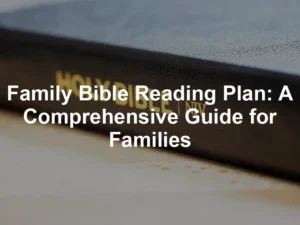Family Bible Reading Plan: A Comprehensive Guide for Families

Introduction
Reading the Bible as a family isn’t just a good idea; it’s a vital practice in today’s world. It serves as a powerful tool for spiritual growth and relationship building. Imagine gathering around the table, laughter blending with profound discussions about faith. Sounds like a scene from a movie, right? Well, it can be your reality! A family Bible reading plan is essentially a structured approach to reading the Bible together. It helps families stay accountable, ensuring that everyone engages with God’s Word regularly. This plan can take many forms, whether it’s daily readings or weekly discussions. The benefits are numerous. First, reading the Bible together nurtures spiritual growth. It’s like water for your soul! Children learn biblical values, while parents reinforce their own understanding. Plus, it creates precious bonding time filled with shared insights. In this article, we’ll explore how to set up a family Bible reading plan, making it both enjoyable and enriching. We’ll discuss formats that work for every family, how to maintain consistency, and ways to keep everyone engaged. Let’s dive into this journey of faith together!
Understanding the Family Bible Reading Plan
What is a Family Bible Reading Plan?
A family Bible reading plan is a roadmap for families to read the Bible together. It typically includes specific passages and a timeline for completion. The plan can be tailored to fit your family’s unique needs, ensuring that everyone can participate. There are various formats available. Some families prefer daily readings, which involve a chapter or two each day. Others might opt for a weekly plan, allowing for deeper discussions on fewer passages. Thematic plans focus on specific topics, guiding families through related scriptures. These options cater to different schedules and preferences, making it easier to stick with the plan.Importance of Family Bible Reading
Reading the Bible as a family is significant for several reasons. First, it fosters spiritual growth. Families learn together, share insights, and hold each other accountable. This shared experience strengthens faith and encourages open discussions about God’s Word. Moreover, family Bible reading teaches children the importance of scripture. It sets a precedent that God’s Word is central to life. As stated in Deuteronomy 6:6-7, parents are called to teach their children diligently. When families engage in Bible reading, they model accountability and commitment to God’s teachings. Additionally, reading together creates shared values. It cultivates an environment where discussions about faith flow naturally. Families can address challenges, explore life lessons, and celebrate spiritual milestones together. This collective journey not only deepens faith but also strengthens familial bonds. In conclusion, a family Bible reading plan is a wonderful way to cultivate faith and unity. The importance of reading the Bible as a family cannot be overstated. It’s a journey that shapes lives and builds deeper connections with God and each other. So, let’s embark on this incredible adventure together!
To explore the significance of a structured approach, consider implementing a family Bible reading plan that fits your family’s needs.
Setting Up Your Family Bible Reading Plan
Choosing a Reading Plan
Selecting the right reading plan is essential. It sets the stage for your family’s biblical adventure! Various types of plans cater to different preferences. First up is the chronological plan. This approach takes you through the Bible from Genesis to Revelation in the order events happened. It’s like watching a movie unfold. The narrative flows, making it easier to grasp the storyline. Next, we have thematic plans. These focus on specific topics, such as faith, love, or family. Families can explore how God’s Word speaks to various aspects of life. For example, the “7 Things the Bible Says About Parenting” plan can spark insightful discussions around family dynamics. Then there’s the narrative plan. This option highlights key biblical stories, focusing on characters and events. A great example is the 5-Day Bible Narrative Plan. It’s designed for busy families, allowing them to digest the Bible in manageable chunks. The M’Cheyne plan is another popular choice. It encourages reading through the Old and New Testaments in a year. It’s perfect for those who want a comprehensive overview. Each day includes a selection from different parts of the Bible, enriching the experience. Deciding which plan suits your family best can be a fun discussion. Consider each member’s age and attention span. Choose a plan that invites everyone into the journey!
Determining the Best Schedule
Consistency is vital for any reading plan. You want to establish a routine that fits your family’s lifestyle. Ask yourselves: will you read daily or weekly? Daily readings can create a seamless habit. However, if your family is busy, a weekly schedule might work better. When setting a schedule, consider everyone’s commitments. Soccer practice, school events, and work schedules can get hectic. Aim for a time when everyone can gather without distractions. Perhaps after dinner or on Sunday mornings? Flexibility is key. If life gets in the way, don’t stress! Just pick back up where you left off. Another tip is to involve your kids in the decision-making process. Ask them when they’d prefer to read. This inclusion fosters accountability and excitement! With a little creativity, you can make Bible reading a cherished family ritual.
Selecting the Right Bible Version
Choosing a Bible translation is crucial for comprehension. You want something accessible to all ages. The New International Version (NIV) Bible is a popular choice. It’s readable and widely used in churches. The New Living Translation (NLT) Bible is another excellent option. It presents the text in contemporary language, making it easy for younger readers to understand. For a more traditional feel, consider the English Standard Version (ESV) Bible. It maintains a balance between readability and accuracy. If you’re reading with very young children, the New International Reader’s Version (NIrV) Bible simplifies language. It’s perfect for early readers, ensuring they grasp the stories and concepts easily. Keep in mind that different family members may have different preferences. Encourage discussions about why specific translations resonate with them. This can enhance understanding and appreciation of the Scriptures.
Gathering Resources
Enhancing your Bible reading experience can be as simple as gathering a few key resources. Devotionals tailored for families can provide context and insights. Consider options like the Jesus-Centered Family Devotions. These are designed to deepen family discussions around scripture. Study guides can also be handy. They often include questions and activities that stimulate conversations. Children’s Bibles, like The Action Bible, can make stories come alive for younger readers. Don’t forget to track progress! Create checklists or journals where family members can note their thoughts. This can serve as a wonderful keepsake. Visual progress markers can also motivate everyone to stay committed. Lastly, utilize technology! There are apps that can help families read together. The YouVersion Bible app offers various reading plans and audio options. This flexibility can cater to busy schedules, allowing families to engage with the Word no matter where they are.
Engaging Your Family in Bible Reading
Making Reading Interactive
Engaging your family in Bible reading goes beyond just opening the book. It’s about sparking lively discussions and creating memorable moments! Here are some tips to make your reading sessions more interactive and fun. Encouraging Discussion: After reading, ask open-ended questions. For instance: – What surprised you about today’s reading? – How do you think the characters felt? – What does this passage teach us about God? These questions help family members share their insights and promote deeper understanding. Encourage kids to express their thoughts, no matter how silly they may seem. You might learn something new! Incorporating Games: Why not spice things up with games? A Bible trivia game can turn learning into a competition. Divide into teams and see who knows the most! Or create a scavenger hunt using Bible verses. For example, “Find a verse that talks about love” leads to fun exploration. Another idea is to act out the stories. Whether it’s Moses parting the Red Sea or David facing Goliath, role-playing can help everyone connect with the story. Laughter and creativity will fill your home while reinforcing the lessons learned.
Addressing Challenges
Every family faces hurdles when it comes to Bible reading. Let’s tackle some common concerns. Sensitive Topics: Kids are curious, and some Bible stories can raise eyebrows. Stories of David and Bathsheba or the violence in the Old Testament might feel daunting. Don’t shy away! Instead, consider skipping particularly sensitive passages for younger kids. You can explain that some stories are better suited for older audiences. Age Differences: Families often have a mix of ages, making it tricky to find common ground. To address this, adapt the language to suit younger children while still engaging older ones. Use simpler terms and concepts for the little ones, while older kids can delve into deeper discussions. This inclusive approach ensures everyone feels involved. Creating Comfort: Make sure to establish a comfortable environment. If family members feel anxious, they may hesitate to share or ask questions. Reassure them that it’s okay not to have all the answers. Encourage a culture of curiosity and respect, where every question is welcome.
Encouraging Consistency
Consistency is key in any family Bible reading plan. So, how can you keep the momentum going? Accountability: Set up a buddy system. Pair family members to check in on each other’s progress. If one person misses a reading, the other can gently remind them. This creates a support system that fosters commitment. Motivation: Celebrate milestones! When your family completes a book or reaches a significant passage, reward yourselves. It could be a special treat or a fun family outing. These celebrations can keep everyone motivated and excited about reading together. Flexible Scheduling: Life gets busy, and it’s easy to let Bible reading slip. If you miss a day or two, don’t panic! Just pick up where you left off. Flexibility is crucial. Whether it’s reading in the morning or after dinner, find what works best for your family.
Supplementing Your Bible Reading
Family Devotionals
Incorporating family devotionals alongside your Bible reading adds depth and richness to your spiritual time together. Think of devotionals as the icing on your Bible cake—sweet and essential! These resources can provide context, encourage discussions, and make lessons relatable to your family’s daily life. Consider starting with Jesus-Centered Family Devotions. This series focuses on Jesus’ teachings and applies them to everyday situations. It’s perfect for families to gather around and discuss how the lessons can be woven into their lives. Another great option is the 7 Things the Bible Says About Parenting, which offers practical insights into family dynamics through a biblical lens. To make it even more engaging, choose a devotional that includes questions at the end of each section. This way, you can unpack the material together. By discussing the content, you create space for everyone to share their thoughts, thus strengthening familial bonds while growing in faith.
Utilizing Media
Let’s face it, sometimes a good old book just doesn’t do the trick! Enter multimedia: the superhero of modern learning. Videos and podcasts can transform your Bible reading experience from mundane to magnificent. One fantastic resource is The Bible Project. They produce animated videos that summarize biblical books and themes, making complicated concepts digestible. Imagine your kids getting excited about a cartoon that explains the book of Leviticus! You can grab their collection on DVD for an easy family movie night! Another gem is RightNow Media, which offers a vast library of Bible studies, family devotionals, and kids’ programming. It’s like Netflix for Christian content! With a subscription, you can stream videos that correspond with your reading plan, allowing you to connect scripture with real-life applications. These multimedia resources can spark interest and engagement, making Bible reading less of a chore and more of an adventure. Plus, they provide a fresh perspective that can lead to lively family discussions.
Community Involvement
While reading the Bible as a family is powerful, connecting with others can amplify that experience. Engaging with a community not only enriches your understanding but also provides support and accountability. Consider joining a Bible study group at your church or organizing a family-friendly study night with other families. Sharing experiences and insights allows everyone to learn from each other’s perspectives. Plus, it’s a great way to build friendships and encourage one another in faith. Participating in church activities is another excellent way to foster community. Whether it’s a family retreat, potluck, or volunteer event, these gatherings strengthen bonds not just between families but also within the church body. As you share your Bible reading journey with others, you’ll find encouragement, resources, and perhaps a bit of humor along the way. After all, who doesn’t love swapping funny stories about the quirks of family Bible reading? So, roll up your sleeves, get connected, and watch your family’s faith deepen as you journey alongside others!
Personal Reflections from Families
Families across the globe are finding joy in their shared Bible reading experiences. Each family’s journey is unique, shaped by their circumstances, ages, and creativity. Let’s peek into some heartwarming anecdotes that showcase the diversity in family Bible reading plans. The Smith family, for example, embraced the M’Cheyne reading plan. With kids aged 7 and 10, they set aside time every evening after dinner. Mom, Sarah, recalls a particularly lively discussion about the story of David and Goliath. “My daughter shouted, ‘If I had a slingshot, I’d take down a giant too!’ Her enthusiasm got us all laughing,” she shared. This playful exchange not only kept the kids engaged but also reinforced the lesson of courage. Meanwhile, the Johnsons found success with a thematic approach. They focused on the fruits of the Spirit. Each week, they read a passage related to kindness, patience, or love. “We’d discuss real-life scenarios,” says dad, Mike. “Like how to show kindness at school. It turned our readings into practical life lessons.” This method helped them connect scripture to daily life, making it relatable and memorable. The Garcia family took a different route. They decided to read the Bible chronologically, but with a twist. They turned it into a family podcast! Each week, they recorded their discussions and reflections on the chapters they read. “It became a family project,” said Maria, the mom. “We laughed, we debated, and we learned together. Now, we have a treasure trove of memories captured!” This creative outlet not only deepened their understanding but also created a lasting keepsake. Even families with younger children can find ways to engage. The Thompsons introduced a children’s Bible that narrates stories with colorful illustrations. “Our kids love it! We read a chapter before bed, and they act out the stories,” said dad, Tom. This interactive element kept the little ones excited about Bible reading, turning it into a fun adventure. Plus, consider incorporating a Kids’ Bible Storybook to help bring the stories to life!
Conclusion
Establishing a family Bible reading plan is more than a mere routine; it’s a profound journey of faith and connection. The importance of reading the Bible together cannot be overstated. It cultivates spiritual growth, accountability, and a shared understanding of God’s teachings. Each family has the opportunity to strengthen their bond while exploring the depths of God’s Word. Encouragement is key. If your family hasn’t embarked on this journey yet, there’s no better time to start. Adapt your plan to suit your unique dynamics, and don’t be afraid to sprinkle in a bit of creativity. Whether through discussions, themed readings, or interactive storytelling, each moment spent in scripture enriches your family’s spiritual life. As you gather around the Bible, remember the words of Psalm 119:105: “Your word is a lamp to my feet and a light for my path.” Let God’s Word illuminate your family’s journey, guiding your hearts and minds closer to Him. Embrace the adventure and cherish the time spent together. Start today, and watch as your family grows in faith and love!
FAQs
What if my kids are too young to understand the Bible?
When it comes to little ones, simplicity is your best friend! Consider using children’s Bibles that retell stories in engaging ways. These versions often include vibrant illustrations that captivate young minds. You can summarize the main points in your own words, making it relatable. For instance, while reading Noah’s Ark, you might say, “God saved animals to keep them safe from a big flood!” This approach not only captures their interest but also helps them grasp fundamental concepts.
How do I keep my family engaged in Bible reading?
Keeping the excitement alive can be as fun as a game night! Create interactive activities related to the stories you read. For instance, after reading about the Good Samaritan, you could discuss ways to help others in your community. Role-playing can also be a hit. Get everyone involved in acting out stories. Ask questions that provoke thought and dialogue, such as, “What would you do in this situation?” By incorporating fun and meaningful discussions, you’ll make Bible reading something your family looks forward to.
Can we skip difficult passages?
Absolutely! Not all scripture is suitable for every age. It’s okay to skip or adapt sensitive topics. For example, instead of discussing complex themes directly, focus on the lessons learned from the characters’ experiences. You can also choose to read lighter, more uplifting stories and tackle deeper themes as your children mature. This way, you maintain a positive atmosphere while still instilling biblical principles.
How can I track our progress?
Tracking progress can be incredibly motivating! Create a visual chart or checklist that everyone can see. You could use stickers for each completed reading or a family journal where everyone writes down their thoughts. This not only makes it fun but also encourages accountability. Celebrate milestones together, whether it’s finishing a book or hitting a specific number of readings. A little friendly competition can also spice things up!
What are some resources to help us?
There are countless resources available to support your family Bible reading journey. Websites like YouVersion offer a variety of reading plans, and the Bible Project provides engaging video overviews of different books. You might also consider family devotionals like “Jesus-Centered Family Devotions” for deeper insights. For younger kids, “The Action Bible” brings stories to life with captivating illustrations. With so many tools at your disposal, you can enhance your family’s Bible reading experience in exciting ways!
All images from Pexels







